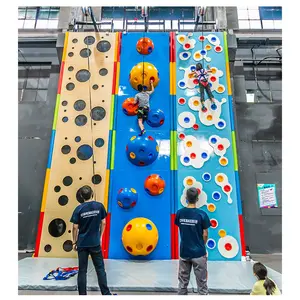
Wholesale Triangle Set Kids Wooden Climbing Piklers Arch Montessori Pickler Triangle Indoor Climbing Frame


Wooden Montessori Rocking Chair Board Wooden Piklers Arch Rocker Balance Board Kids Toy Arch Rocker Climbing Arch























A rock climbing wall is a specially designed structure that mimics the features and challenges of outdoor rock formations, allowing individuals to practice and enjoy the sport of rock climbing in a controlled environment. Rock climbing walls have come a long way since their inception. Originally introduced as training tools for mountaineers, they have become standalone attractions in gyms, recreational centers, and outdoor adventure parks. Modern climbing walls are meticulously designed to simulate the intricacies of outdoor rock formations, offering climbers a diverse range of holds, surfaces, and inclines.
Kids rock climbing wall has scaled-down walls with holds and features suitable for children. Rock climbing walls for kids introduce children to climbing safely and enjoyably. Setting up an indoor rock climbing wall is a fantastic way to bring the thrill of climbing into the home or a dedicated indoor space. Artificial ice climbing wall simulates the challenges of ice climbing with textured surfaces and ice-like holds. It allows climbers to practice ice-climbing techniques in a controlled environment. A backyard rock climbing wall can be a fantastic addition for recreational climbing enthusiasts and families seeking an engaging outdoor activity. Creating a DIY rock climbing wall can be a rewarding project that allows one to customize the climbing experience based on their preferences and available space.
Rock climbing wall design is a crucial aspect that contributes to the overall climbing experience. Walls are constructed with various features such as jugs (large holds), crimps (smaller holds), slopers (smooth surfaces), and overhangs. The arrangement of these features challenges climbers to strategize their ascent, combining strength, balance, and problem-solving skills. While rock climbing is inherently risky, indoor climbing walls prioritize safety. Climbers are typically harnessed to a rope system, and crash pads are strategically placed to cushion falls. Climbing walls often have markings to indicate the starting and finishing points of routes and the difficulty level. Grading systems help climbers understand the challenge they are undertaking. The lighting and overall atmosphere of the climbing gym contribute to the overall experience. Well-lit walls and a welcoming environment enhance the enjoyment of climbing. Climbing gyms often include communal areas for socializing, gear storage, and relaxation. These areas can foster a sense of community among climbers.
Rock climbing walls provide a full-body workout, engaging muscles in the arms, legs, core, and back. The dynamic movements required during climbing improve flexibility, strength, and cardiovascular fitness. Additionally, the mental aspect of climbing is equally significant. Climbers must focus on each move, strategize their route, and conquer any fears or doubts, fostering mental resilience and concentration. Engaging in physical activity, such as climbing, can help reduce stress levels. Combining physical effort and mental focus can provide a welcome distraction from everyday stressors. Climbing is often a social activity that encourages interaction with other climbers. Whether discussing routes, offering encouragement, or belaying for a partner, climbing fosters community. Find sturdy rock climbing wall for sale including home rock climbing wall at Alibaba.com.